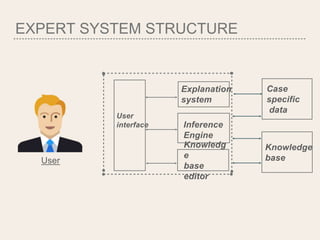Expert system
- 2. EXPERT SYSTEM âĪ An expert system is a computer-based system that uses knowledge, facts, and reasoning had by a human as an expert which is saved in the computer, and used to solve problems that usually need an expert (James Martin and Steve Oxman, Building Expert System (A Tutorial ), 1998)
- 3. Knowledge - base Interface Engine User Facts Expertise
- 4. WHY USE EXPERT SYSTEM âĪ Experts are not always available. An expert system can be used anywhere, anytime. âĪ Human experts are not 100% reliable or consistent âĪ Experts may not be good at explaining decisions âĪ Cost effective
- 5. WHEN TO USE AN EXPERT SYSTEM âĒ The problem cannot be specified in terms of a well defined algorithm. âĒ When the task is hazardous âĒ There is a scarcity of experts in the area. âĒ The problem requires consistency and standardisation. âĒ Human experts have successfully solved similar problems
- 6. BASIC CONCEPTS âĪ Expert An expert is a person with extensive knowledge or abilities in a particular area of study. âĪ Expertise Something that we can get from learning, reading, and practicing including implicit and explicit knowledge âĪ Knowledge Acquisition Knowledge acquisition is a data-collecting procedure from an expert to the system (computer software)
- 7. CHARACTERISTICS âĪ It is capable of handling challenging decision problems. âĪ It uses knowledge rather than data for solution. âĪ The knowledge is encoded and maintained separately
- 8. EXPERT SYSTEM MODULE Knowledge base Inference engine User interface Human expert Knowledge engineer User
- 9. âĪ Knowledge Acquisition Module In this module, Expert System get knowledge from human experts. âĪ Consultation Module In this module, Expert Systems give answers for the users' problems. âĪ Explanation Module In this module, Expert Systems give explanation about how answers have been inferred.
- 11. ADVANTAGES Increased availability Reduced Cost Reduced Danger Permanence Increased reliability Explanation Fast Response Multiple Expertise
- 12. DISADVANTAGES Incomplete information Dissimilarity in information received Time consuming High cost involved
Editor's Notes
- #4: User supplies facts or other information to the expert system and receives expert advice or expertise in response Internally, the expert system consists of two main components : the knowledge-base contains the knowledge the inference engine draws conclusions from the knowledge The expert knowledge is specific to a problem domain, i.e. medicine, finance, science, etc. However, within the problem domain there is the knowledge domain of the expert or system, which is a wholly contained subset of the problem domain In the knowledge domain, an expert system reasons or makes inferences in the same way that a human expert would infer the solution of a problem. Expert systems can be used as replacements for human experts, in situations where the problem domain is small and well-defined and the knowledge domain of the system is equivalent. However, they are more widely used as intelligent assistants, i.e. decision support systems
- #11: The user interacts with the system through a user interface which may use menus, natural language or any other style of interaction). Then an inference engine is used to reason with both the expert knowledge (extracted from our friendly expert) and data specific to the particular problem being solved. The expert knowledge will typically be in the form of a set of IF-THEN rules. The case specific data includes both data provided by the user and partial conclusions (along with certainty measures) based on this data. In a simple forward chaining rule-based system the case specific data will be the elements in working memory. Almost all expert systems also have an explanation subsystem, which allows the program to explain its reasoning to the user. Some systems also have a knowledge base editor which help the expert or knowledge engineer to easily update and check the knowledge base. One important feature of expert systems is the way they (usually) separate domain specific knowledge from more general purpose reasoning and representation techniques. The general purpose bit (in the dotted box in the figure) is referred to as an expert system shell. As we see in the figure, the shell will provide the inference engine (and knowledge representation scheme), a user interface, an explanation system and sometimes a knowledge base editor. Given a new kind of problem to solve (say, car design), we can usually find a shell that provides the right sort of support for that problem, so all we need to do is provide the expert knowledge. There are numerous commercial expert system shells, each one appropriate for a slightly different range of problems. (Expert systems work in industry includes both writing expert system shells and writing expert systems using shells.) Using shells to write expert systems generally greatly reduces the cost and time of development (compared with writing the expert system from scratch).
- #12: 1.Increased availability expertise becomes available on any suitable computer hardware, thus the system disseminates expertise more widely 2 .Reduced Cost cost per user of providing expertise is lowered 3. Reduced Danger expert systems can be used in situations that would be hazardous to a human 4. Permanence human experts are impermanent 5. Increased Reliability not subject to human variability can be used to confirm or increase confidence that correct decision has been reached. Not advisable if human expert being assisted by system was the one who designed the system 6. Explanation system can explicitly explain in detail to all interested parties, at all times, the reasoning that leads to a conclusion. This increases confidence in the decision, and a human expert would be unlikely to have the time, or the patience, to do this. 7. Fast Response For some applications, especially real-time systems, the expert system may respond faster and be more available than the human expert. 8. Multiple expertise can include the expertise of several human experts













